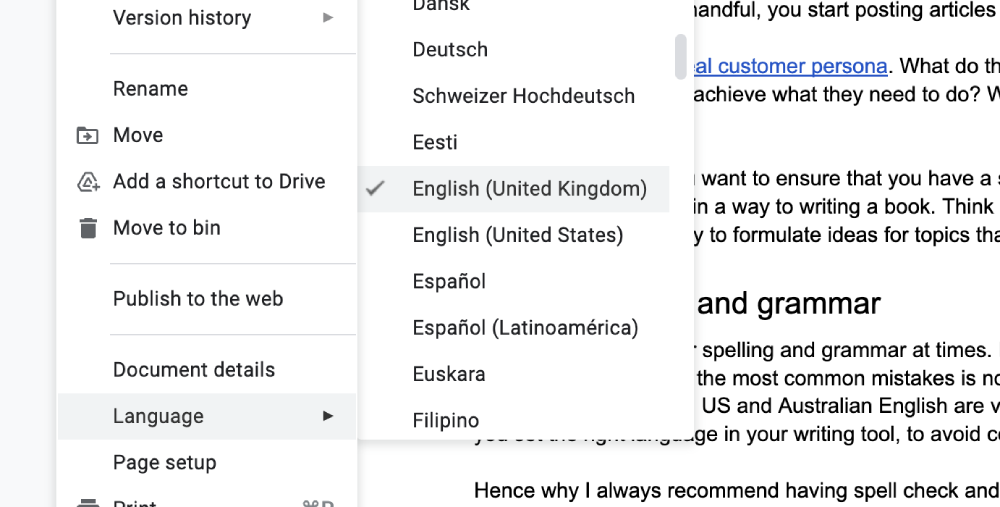If you are marketing a SaaS product (or any product, really), it is very likely that you are aware of the importance of having a blog to support your other marketing activities. The SEO and audience attracting benefits of blogging makes it a very cost effective tool for your SaaS marketing toolkit.
However, because everyone knows this, many people just dive in with no focus or thought on how to approach SaaS blogging, and they instead publish a handful of posts, get zero traction, and then just give up on that channel.
That’s absolutely not the right way to go about things. Here are my pet hates in one list. These eight blogging mistakes will not help your journey towards success, so avoid them at all costs.
The points are;
- Publish infrequently
- Write purely for SEO
- Have inconsistent topics
- Terrible spelling and grammar
- Focus only on yourself
- Have no consistency
- Write spammy headlines
- Only publish product updates
So, now let’s get into the nitty gritty, where I explain each of these and what it means in more detail.
Publish infrequently
Yes, I know, pot calling the kettle black. My personal blog, the one you are reading now, can often go months without a new post. I’m fine with that though; this is a personal blog with no specific aim of attracting new clients or customers. My other business blogs, I assure you, have frequent (or at least consistent) publishing workflows.
There’s a tendency for new bloggers to pump out lots of posts a week apart at the start, and then 3-4 months in, it slows down to fortnightly or monthly, and then eventually the blog starts collecting cobwebs.
A good way to avoid this on again off again style of publishing, is to have a few posts up your sleeve, so when you do have a lull in blog writing, at least you can keep up the publishing frequency.
Write purely for SEO
We have all seen these in action. Someone reads about the SEO benefits of blogging, and therefore they start writing post after post targeting keywords and purely focusing on search engines, and not humans. This is called keyword stuffing, and is both bad for human readers, and Google is typically wise to it as well.
These writers forget that it is humans who are the ones who need to read and understand your content. That way, if they enjoy your writing, they will share it, link to it, spread it around for others to enjoy. That’s the core basis of building an audience organically.
On the other hand, when I see an article which is brimming with keywords and it doesn’t read well, I know the writer is putting the value of Google Bot above me as a human reader. What a good way to alienate your readers and pretty quickly too!
Yes, it is important to optimise every blog post for SEO, but don’t make the mistake of writing for search engines first.

SaaS blogging tip: Avoid keyword stuffing
Have inconsistent topics
You start with all great intentions. You post about topics that your ideal customer will appreciate, but after a handful, you start posting articles on all sorts of random topics.
Always refer to your ideal customer persona. What do they want to read about, and how can your articles help them achieve what they need to do? What problems can you solve for them?
As a SaaS blogger, you want to ensure you have a suite of blog topic ideas that can grow over time, similar in a way to writing a book. Think of all the chapters in a nonfiction book. That’s a good way to formulate ideas for topics which your ideal customers want to read.
Terrible spelling and grammar
We are all guilty of poor spelling and grammar at times. Hell, even the biggest brands can make mistakes. One of the most common mistakes is not choosing a version of English to stick with. For example, US and Australian English are very different beasts.
Your choice of English depends on what audience you are targeting, and whether you want to stick to the language from your country or not. Always ensure you set the right language in your writing tool, to avoid confusion.
Hence why I always recommend having spell check and grammar tools in your workflow, such as Hemingway, Grammarly or even Google Docs, whose inbuilt dictionary is very good at spotting grammatical issues as well as poor spelling.
In an ideal world, ask a colleague or friend to proofread your article as well. I often find I can always pick up a few things which software hasn’t managed to spot.
- SaaS blogging tip: use the right language consistently
Focus only on yourself
I bet you’ve seen this yourself. You find a blog, think it’s going to be great and then realise every single post is about them, and not you or your interests. Literally how great their product is, how great their customers think they are, what a great team they are, blah blah blah.
Who wants to read a blog post such as that? I always use the analogy of attending some dinner party and sitting next to someone who spends the entire evening telling you about how great they are. You’ll do anything to move seats, won’t you? That’s exactly what your blog readers will think too.
Before writing on a topic, ask yourself if your target audience will find the post interesting and engaging. If not, save yourself the effort and don’t write it. SaaS marketing and blogging isn’t just telling the world how great your product is; it is showing your target audience you understand them, and then show you can genuinely help them.
Have no consistency
When I talk about consistency, I don’t mean publishing frequency, but rather layout and tone. You should aim to have a consistent post length, tone and structure. For example, take a look at the 6Q blog.
Any post that we publish starts with a descriptive sentence or two, leading the reader in. Then there are paragraphs no longer than 5-6 lines in length. The sub headings are all in standard H3 or H4, and then there’s an In Summary section.
That way, regular readers learn what to expect, and will appreciate the consistent reading.
Write spammy headlines
For a while there, there was a trend on popular sites to have ridiculously spammy sounding clickbait headlines. You know the ones, “270 ways to be insanely great at everything!”, or “How aliens took over the world. You won’t believe how!”.
It didn’t take long for people to realise that many of the sites publishing these were preying on people’s FOMO and other emotions to get people to click. 99% of the time, the actual articles were below average anyway – the title was the only thing encouraging readers.
Sure, you can borrow some inspiration from them, and you should be using lots of tests to find the perfect headline, but outlandish headlines that look like clickbait do your blog a disservice.
- SaaS Blogging tip: Avoid ridiculous clickbait headlines
Only publish product updates
There’s nothing wrong with product updates. It is vitally important to share what you are doing, to ensure your SaaS product is up to date and consistently evolving. I often look for them when evaluating a SaaS product, and I imagine many others do the same.
However, rather than publishing your product updates on your main blog though, you are likely far better off using a changelog or dedicated release notes area, such as what the likes of Xero, Appbot or Help Scout do.
That way, you aren’t confusing audience expectations. Sure, the Help Scout example above is actually within their blog, however it is in a category of its own, to keep the expectations consistent.
In Summary
As we discussed above, the eight ways to ensure you drive away any audience and ensure you fail at SaaS blogging, are;
- Publish infrequently
- Write purely for SEO
- Have inconsistent topics
- Terrible spelling and grammar
- Focus only on yourself
- Have no consistency
- Write spammy headlines
- Only publish product updates
Avoid these, and you are on the way to good things. All the best with your SaaS blogging in the future!



 Entrepreneur,
Entrepreneur, 